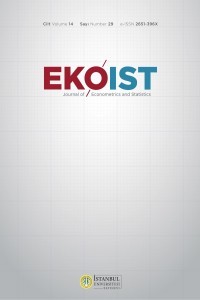OECD Ülkelerinde İşsizliğin Histeri ve Doğal Oran Çerçevesinde İncelenmesi: Alternatif Panel Birim Kök Testlerinden Kanıtlar
İşsizlik önemli makro ekonomik sorunlardan birisi olması özelliğini sürdürmekte, olumsuz etkileri ekonomik düzeyde kalmayıp sosyal düzeyde de tüm toplumlarda görülmektedir. Aralık 2020 verilerine göre Ekonomik İşbirliği ve Kalkınma Örgütü’ne (OECD) üye ülkeler arasında işsizlik oranı Covid-19 pandemisinin henüz işgücü piyasasını sarsmadığı Şubat ayına göre 1,7 puan artarak %6,9 olarak gerçekleşmiştir. Pandemi süreci gibi yaşanan şokların işsizlik oranları üzerindeki etkilerinin geçici mi yoksa kalıcı mı olduğunun işsizlikle etkin mücadele edilebilmesi için doğru tespit edilmesi gerekmektedir. İşsizlik oranının seyriyle ilgili üç temel yaklaşım bulunmaktadır. Doğal oran hipotezine göre işsizlik serisi durağan iken histeri hipotezine göre birim kök içermekte, yapısalcı yaklaşıma göre ise kırılmalar olsa da durağan bir seyir izlemektedir. Bu çalışmada 30 OECD ülkesinin 2001-2020 yılları arası aylık işsizlik verileri kullanılmıştır. Bu çalışmanın literatüre katkısı pandeminin OECD ülkelerindeki etkisinin 2020 yılına ait aylık verilerin analize katılmasıyla gerçekleşmektedir. Mevsimsellikten arındırılan serilerde yatay kesit bağımlılığı kontrol edildikten sonra histeri veya doğal oran hipotezlerinin geçerliliği yatay kesit bağımlılığını dikkate alan ikinci nesil panel birim kök testleri ile araştırılmıştır. Sırasıyla Pesaran (2007), Smith (2005), Hadri ve Kurozumi (2012) panel birim kök testleri ve daha sonra Nazlıoglu ve Karul (2017) Fourier panel birim kök testleri uygulanmıştır. Uygulanan testlerin tümünün sonuçları OECD paneli için histeri hipotezini doğrulamaktadır. Sonuçlar, OECD genelinde işsizlik oranını etkileyen şokların kalıcı etkiler bırakacağını göstermektedir.
Examination of Unemployment in the Framework of Hysteresis and Natural Rate in OECD Countries: Evidence from Alternative Panel Unit Root Tests
Unemployment continues to be one of the important macroeconomic problems, its negative effects are not only seen at the economic level, but also in all societies at the social level. According to December 2020 data, the unemployment rate among the member countries of the Organization for Economic Cooperation and Development (OECD) increased by 1.7 points to 6.9% compared to February, when the Covid-19 pandemic had not yet shaken the labor market. Whether the effects of shocks, such as the pandemic process, on unemployment rates are temporary or permanent, it is necessary to accurately determine to fight unemployment effectively. There are three basic approaches to the course of the unemployment rate. While the unemployment series is stationary according to the natural rate hypothesis, it contains a unit root according to the hysteresis hypothesis, and according to the structuralist approach, it follows a stationary course even though there are breaks. In this study, monthly unemployment data of 30 OECD countries between 2001 and 2020 were used. The contribution of this study to the literature is realized by adding the monthly data of 2020 to the analysis of the effect of the pandemic in OECD countries. After controlling for the cross-sectional dependence in the seasonally adjusted series, the validity of the hysteresis or the natural rate hypothesis was investigated with second-generation panel unit root tests that consider the cross-sectional dependence. Pesaran (2007), Smith (2005), Hadri and Kurozumi (2012) panel unit root tests and then Nazlıoglu and Karul (2017) Fourier panel unit root tests were applied, respectively. The results of all tests performed confirm the hysteresis hypothesis for the OECD panel. The results show that shocks affecting the unemployment rate across the OECD will have lasting effects.
___
- Blanchard, O. J., & Summers, L. H. (1986). Hysteresis and the European Unemployment Problem. NBER Macroeconomics Annual, 1, 78. https://doi.org/10.2307/3585159
Camarero, M., & Tamarit, C. (2004). Hysteresis vs. natural rate of unemployment: New evidence for OECD countries. Economics Letters, 84(3), 413–417. https://doi.org/10.1016/J.ECONLET.2004.02.014
